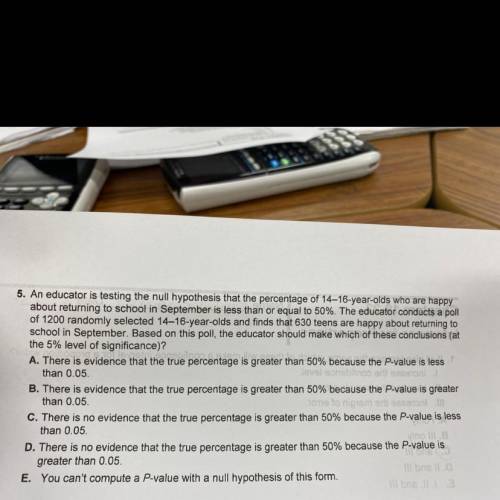
Mathematics, 25.02.2020 00:47 foxesforlife45
5. An educator is testing the null hypothesis that the percentage of 14-16-year-olds who are happy
about returning to school in September is less than or equal to 50%. The educator conducts a poll
of 1200 randomly selected 14-16-year-olds and finds that 630 teens are happy about returning to
school in September. Based on this poll, the educator should make which of these conclusions (at
the 5% level of significance)?
A. There is evidence that the true percentage is greater than 50% because the P-value is less
than 0.05.
B. There is evidence that the true percentage is greater than 50% because the P-value is greater
than 0.05.
C. There is no evidence that the true percentage is greater than 50% because the P-value is less
than 0.05.
D. There is no evidence that the true percentage is greater than 50% because the P-value is
greater than 0.05.
E. You can't compute a P-value with a null hypothesis of this form.


Answers: 3


Other questions on the subject: Mathematics

Mathematics, 21.06.2019 18:10, chyyy3
The means and mean absolute deviations of the individual times of members on two 4x400-meter relay track teams are shown in the table below. means and mean absolute deviations of individual times of members of 4x400-meter relay track teams team a team b mean 59.32 s 59.1 s mean absolute deviation 1.5 s 245 what percent of team b's mean absolute deviation is the difference in the means? 9% 15% 25% 65%
Answers: 2



Mathematics, 22.06.2019 02:30, arrichardson787
Aresearch study is studying the effects of a new drug for osteoporosis alzheimer's disease (ad) for women above the age of 65 years. a group of individuals with osteoporosis is randomized into two groups. one group is treated conventionally, and the second group is treated with the new medication. assessments are made at 3, 6, 12, 36, and 48 months. the conventionally treated group is assessed for ad using a serum blood test, and the treatment group is assessed for ad using a pet radiotracer that binds to beta-amyloid plaques. in comparing these 2 trial arms, the authors of the study may encounter which type of bias? a. selection bias on the risk of developing b. measurement bias c. confounding bias d. recall bias e. lead-time bias
Answers: 2
You know the right answer?
5. An educator is testing the null hypothesis that the percentage of 14-16-year-olds who are happy
Questions in other subjects:












